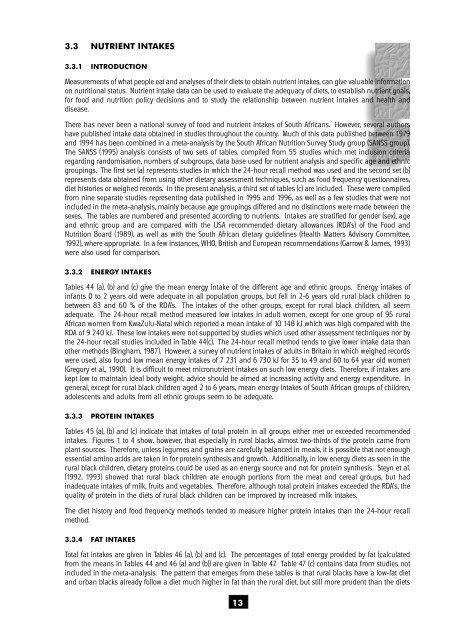the nutritional status of - Health Systems Trust
the nutritional status of - Health Systems Trust
the nutritional status of - Health Systems Trust
You also want an ePaper? Increase the reach of your titles
YUMPU automatically turns print PDFs into web optimized ePapers that Google loves.
3.3 NUTRIENT INTAKES<br />
3.3.1 INTRODUCTION<br />
Measurements <strong>of</strong> what people eat and analyses <strong>of</strong> <strong>the</strong>ir diets to obtain nutrient intakes, can give valuable information<br />
on <strong>nutritional</strong> <strong>status</strong>. Nutrient intake data can be used to evaluate <strong>the</strong> adequacy <strong>of</strong> diets, to establish nutrient goals,<br />
for food and nutrition policy decisions and to study <strong>the</strong> relationship between nutrient intakes and health and<br />
disease.<br />
There has never been a national survey <strong>of</strong> food and nutrient intakes <strong>of</strong> South Africans. However, several authors<br />
have published intake data obtained in studies throughout <strong>the</strong> country. Much <strong>of</strong> this data published between 1979<br />
and 1994 has been combined in a meta-analysis by <strong>the</strong> South African Nutrition Survey Study group (SANSS group).<br />
The SANSS (1995) analysis consists <strong>of</strong> two sets <strong>of</strong> tables, compiled from 55 studies which met inclusion criteria<br />
regarding randomisation, numbers <strong>of</strong> subgroups, data base used for nutrient analysis and specific age and ethnic<br />
groupings. The first set (a) represents studies in which <strong>the</strong> 24-hour recall method was used and <strong>the</strong> second set (b)<br />
represents data obtained from using o<strong>the</strong>r dietary assessment techniques, such as food frequency questionnaires,<br />
diet histories or weighed records. In <strong>the</strong> present analysis, a third set <strong>of</strong> tables (c) are included. These were compiled<br />
from nine separate studies representing data published in 1995 and 1996, as well as a few studies that were not<br />
included in <strong>the</strong> meta-analysis, mainly because age groupings differed and no distinctions were made between <strong>the</strong><br />
sexes. The tables are numbered and presented according to nutrients. Intakes are stratified for gender (sex), age<br />
and ethnic group and are compared with <strong>the</strong> USA recommended dietary allowances (RDA’s) <strong>of</strong> <strong>the</strong> Food and<br />
Nutrition Board (1989), as well as with <strong>the</strong> South African dietary guidelines (<strong>Health</strong> Matters Advisory Committee,<br />
1992), where appropriate. In a few instances, WHO, British and European recommendations (Garrow & James, 1993)<br />
were also used for comparison.<br />
3.3.2 ENERGY INTAKES<br />
Tables 44 (a), (b) and (c) give <strong>the</strong> mean energy intake <strong>of</strong> <strong>the</strong> different age and ethnic groups. Energy intakes <strong>of</strong><br />
infants 0 to 2 years old were adequate in all population groups, but fell in 2-6 years old rural black children to<br />
between 83 and 60 % <strong>of</strong> <strong>the</strong> RDA’s. The intakes <strong>of</strong> <strong>the</strong> o<strong>the</strong>r groups, except for rural black children, all seem<br />
adequate. The 24-hour recall method measured low intakes in adult women, except for one group <strong>of</strong> 95 rural<br />
African women from KwaZulu-Natal which reported a mean intake <strong>of</strong> 10 148 kJ which was high compared with <strong>the</strong><br />
RDA <strong>of</strong> 9 240 kJ. These low intakes were not supported by studies which used o<strong>the</strong>r assessment techniques nor by<br />
<strong>the</strong> 24-hour recall studies included in Table 44(c). The 24-hour recall method tends to give lower intake data than<br />
o<strong>the</strong>r methods (Bingham, 1987). However, a survey <strong>of</strong> nutrient intakes <strong>of</strong> adults in Britain in which weighed records<br />
were used, also found low mean energy intakes <strong>of</strong> 7 231 and 6 730 kJ for 35 to 49 and 60 to 64 year old women<br />
(Gregory et al., 1990). It is difficult to meet micronutrient intakes on such low energy diets. Therefore, if intakes are<br />
kept low to maintain ideal body weight, advice should be aimed at increasing activity and energy expenditure. In<br />
general, except for rural black children aged 2 to 6 years, mean energy intakes <strong>of</strong> South African groups <strong>of</strong> children,<br />
adolescents and adults from all ethnic groups seem to be adequate.<br />
3.3.3 PROTEIN INTAKES<br />
Tables 45 (a), (b) and (c) indicate that intakes <strong>of</strong> total protein in all groups ei<strong>the</strong>r met or exceeded recommended<br />
intakes. Figures 1 to 4 show, however, that especially in rural blacks, almost two-thirds <strong>of</strong> <strong>the</strong> protein came from<br />
plant sources. Therefore, unless legumes and grains are carefully balanced in meals, it is possible that not enough<br />
essential amino acids are taken in for protein syn<strong>the</strong>sis and growth. Additionally, in low energy diets as seen in <strong>the</strong><br />
rural black children, dietary proteins could be used as an energy source and not for protein syn<strong>the</strong>sis. Steyn et al.<br />
(1992, 1993) showed that rural black children ate enough portions from <strong>the</strong> meat and cereal groups, but had<br />
inadequate intakes <strong>of</strong> milk, fruits and vegetables. Therefore, although total protein intakes exceeded <strong>the</strong> RDA’s, <strong>the</strong><br />
quality <strong>of</strong> protein in <strong>the</strong> diets <strong>of</strong> rural black children can be improved by increased milk intakes.<br />
The diet history and food frequency methods tended to measure higher protein intakes than <strong>the</strong> 24-hour recall<br />
method.<br />
3.3.4 FAT INTAKES<br />
Total fat intakes are given in Tables 46 (a), (b) and (c). The percentages <strong>of</strong> total energy provided by fat (calculated<br />
from <strong>the</strong> means in Tables 44 and 46 (a) and (b)) are given in Table 47. Table 47 (c) contains data from studies not<br />
included in <strong>the</strong> meta-analysis. The pattern that emerges from <strong>the</strong>se tables is that rural blacks have a low-fat diet<br />
and urban blacks already follow a diet much higher in fat than <strong>the</strong> rural diet, but still more prudent than <strong>the</strong> diets<br />
13
















